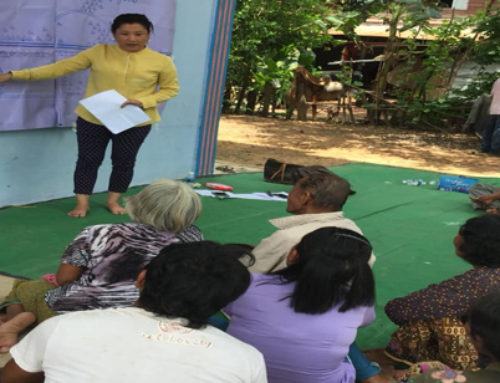A recent article in a leading Bengali daily put the spotlight on Charida village in Purulia district of West Bengal known for its famous Chhau Mask. The reasons this time were rather unpleasant. Despite the on-going nationwide campaign of Swachh Bharat Mission in India, Charida has been unable to eliminate the practice of open defecation yet. What drives people to go back to the harmful practice of open defecation and how can CLTS help in reversing the process, read on to find out…
One can easily enumerate the many milestones Community-Led Total Sanitation (CLTS) has contributed toward the goal of achieving a world free from open defecation (OD). The CLTS approach to sanitation has come far from its humble beginnings in Bangladesh in 2003. Since then, 50 million people now live in OD free (ODF) environments in 66 countries across Africa, Asia, Latin America, the Middle East, the Pacific Islands, and the Caribbean due to the adoption of CLTS by various governments and international agencies, bringing with it many positive outcomes for health and human dignity.
While it has enjoyed widespread success over a range of geographical and social contexts, a number of challenges and concerns have arisen concerning the efficacy of CLTS not only to galvanize communities into ending OD but also to remain ODF. Unfortunately, it is not uncommon for people who had built and used latrines to abandon them and resume the practice of OD. While poorly implemented CLTS has resulted in communities that have not become ODF, many factors play into a community’s failure to become ODF. However, it is chiefly the recidivism back to OD that is the most prevalent obstacle to sustained behaviour change. Why do communities recede back into the practice of OD? And what is responsible for this ‘backsliding’ of sanitation practices after communities? Further, how can these gaps be addressed and reflected in future CLTS planning and implementation exercises?
While a comprehensive analysis of sanitation recidivism is beyond the scope of this article, a combination of factors influences a society’s decision to collectively end the practice of OD and remain ODF. In 2013, a case study studying 4960 households in 116 African villages that had been declared ODF for two or more years found that 92% of the households had receded back to the practice of OD.1 Physical factors include sandy soil, heavy floods or rains, and termite attacks, and can lead to the destruction or collapse of latrines that have been built. A host of cultural and socioeconomic factors include age, sex, education, income, household size, local leadership, and religious beliefs often act concomitantly to undermine sustained behaviour change concerning OD and determine whether communities will strive to remain ODF.
CLTS cannot change fixed physical factors that contribute to the decline in post-CLTS latrine usage. As mentioned previously, difficult soil conditions, excessively wet or dry climatic conditions, and pestilence all play an important part in determining whether individuals or communities rebuild their sanitation hardware or not. In this case, community living in an area with consistently heavy rain or floods might become discouraged and abandon their broken, full or overflowing latrines.2 For instance, many ODF communities in the northern district of Nampula, Mozambique fell victim to heavy flooding in 2015 which destroyed 10,860 homes.3 A follow-up survey indicated that many latrines had collapsed, and so their sanitation status could not be defined.
A community’s morale (or lack thereof), as well as its perception concerning its abilities to rebuild latrines, the longevity of the latrines, and the material resources, required clearly influences the decision to remain ODF or slide back into the practice of defecating in the open. In many cases, poorly designed latrines that were used for a short period were eventually abandoned due to issues with poorly constructed doors, roofs, pans, and pits.4
Cultural and economic barriers to sustained behaviour change are, however, more readily addressed by the CLTS approach. In many communities, beliefs about ritual purity and pollution concerning latrines, education about sanitation and health issues, the size and income of a household, plays an important part in their use even after they have been constructed. In Northern Mozambique for example, a study shows that more years spent in school is associated with a higher likelihood of rebuilding a latrine.5 Some community members like farmers find it burdensome to use a latrine in the middle of a working day, while others such as the elderly are less likely to use a latrine due to the sanitation habits they have adopted for many decades.6 One notices that many of these are indeed the same factors that discourage latrine construction and use, to begin with.
Arguably, however, it is primarily a community’s social dynamic and environment that plays the largest role in its decision to become or remain ODF or continue the practice of OD. Changing the way community members interact with and relate to each other in the context of health and sanitation is central to the CLTS approach. Therefore, the concepts of social capital, social dilemma, and social identity need to be considered in order to delineate and relate the overarching social challenges with sanitation backsliding. While social dilemmas describe situations in which individuals are better off not doing something which benefits the whole group, social capital encapsulates factors as trust, cooperation, communication, and social cohesion within a community.7 Lastly, social identity illustrates how well individuals are connected within a group and how strong intra-group ties are.8
It is here that CLTS can make the biggest difference in the behaviours and attitude of community members towards each other with respect to health, sanitation, and general social cohesion. Communities with higher collective ambitions to reduce or eliminate OD, as well as higher levels of solidarity, trust and cohesion between residents are more likely to make the required efforts to galvanize the community into shaping solutions to their specific sanitation situation. When conducting pre-triggering and triggering exercises, CLTS facilitators must accurately investigate the social capital of a community and emphasize its importance in the process of eliminating OD, capitalizing on it if it is strong, and seeking to augment it if it weak. In this context, issues such as feelings of vulnerability to disease, latrine ownership, cooperation in building sanitation hardware, and confidence in the ability of others should be emphasized to all community members to give a sense of a shared risk as well as a goal. Ultimately, it must be effectively demonstrated that building, owning, and maintaining a latrine poses little risk or cost to a household.
Health concerns are also big drivers for communities to strive towards eliminating OD. In Benin, a study demonstrated that latrine users felt safe from contact with harmful bacteria or viruses by using a latrine. They are also more likely to rebuild or repair a damaged latrine than to recede back into the practice of OD.9
The pre-triggering and triggering exercises could also extend to teaching communities how to evaluate their physical environment and advising them on how best to optimize resources towards the design and development of sanitation hardware, especially in areas where soil conditions are poor and communities are not likely to rebuild damaged latrines.10 Moreover, it would also be highly beneficial if organizations implementing CLTS provided communities with comprehensive guidance on how to maintain and empty existing latrines so they may be used again. This is especially important as several studies have demonstrated that latrines are often abandoned when they are full.11
CLTS interventions must, therefore, be adjusted and customized to fit the needs and tackle the challenges unique to a community, and must also attempt to successfully change some of the conditions that facilitate the decision to reconstruct or continue using a latrine. If it is possible to ascertain how the success of CLTS in influencing sanitation behaviour is related to structural, social, and individual conditions, then CLTS can be improved and amended so that it encourages collective behaviour change within the community that not only supports the goal of becoming or remaining ODF but also equips community members to better assess the obstacles to that goal. The addition of data-based behaviour change strategies within the CLTS framework could improve its effectiveness even more. As such, such strategies could target and augment factors like education, social cohesion and trust, vulnerability to disease and community health concerns, perceptions towards latrine ownership, and confidence in latrine construction, rebuilding and repair.
While the responsibility of not sliding back to OD does lie upon the community, it would be beneficial for various implementers of CLTS around the globe to incorporate the above factors into all their triggering exercises. CLTS has indeed succeeded in transforming the mindsets of myriad communities to recognize the dangers of OD. However, an improved framework of behaviour change that not only empowers a community to accurately assess its sanitation goals, but also allows for the establishment of stronger social capital, would only hasten the achievement of Sustainable Development Goal 6.2.
Featured image source: https://www.hindustantimes.com/mumbai-news/here-s-proof-mumbai-isn-t-free-of-open-defecation/story-3qSgOZdv3rspFgpXQPe0JM.html
1,2 Tyndale-Biscoe P, Bond M, Kidd R. ODF Sustainability Study. FH Designs Australia: PLAN International. 2013:1±181.
3 Mozambique: Floods Emergency Appeal MDRMZ011 Final Report: International Federation of Red Cross and Red Crescent Societies, 2015
4,5, 10,11 Mosler, Hans-Joachim, et al. “Is Community-Led Total Sanitation Connected to the Rebuilding of Latrines? Quantitative Evidence from Mozambique.” Plos One, vol. 13, no. 5, 2018, doi:10.1371/journal.pone.0197483.
6 Routray, Parimita, et al. “Socio-Cultural and Behavioural Factors Constraining Latrine Adoption in Rural Coastal Odisha: an Exploratory Qualitative Study.” BMC Public Health, vol. 15, no. 1, 2015, doi:10.1186/s12889-015-2206-3.
7 Grootaert C. Measuring social capital: an integrated questionnaire: World Bank Publications; 2004.8 Cameron JE. A three-factor model of social identity. Self and identity. 2004; 3(3):239±62.
9 Jenkins MW, Curtis V. Achieving the ‘good life’: why some people want latrines in rural Benin. Soc SciMed. 2005; 61(11):2446±59.







Leave A Comment